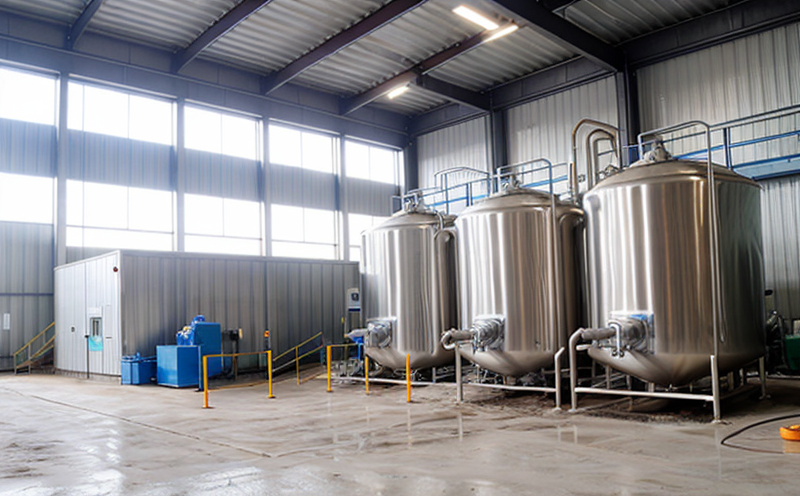ASTM D1426 Ammonia Test in Industrial Water
The ASTM D1426 standard method is widely recognized as a critical tool for measuring ammonia content in industrial water. This test is essential for ensuring the safety and efficiency of processes that involve water, particularly those in sectors like power generation, chemical processing, and manufacturing.
Ammonia is often introduced into industrial water systems through various sources such as cooling towers, boiler feedwater, or process waters. Excessive ammonia can lead to corrosion, scaling, and the formation of harmful compounds, which can compromise the integrity of equipment and impact product quality. Therefore, precise measurement and control are crucial.
The ASTM D1426 method involves the use of a colorimetric procedure with phenolpthalein indicator for potentiometric titration. This approach ensures accurate and reliable results, making it suitable for both routine monitoring and compliance testing. The test is conducted in accordance with internationally recognized standards, ensuring consistency and reliability across different laboratories.
The process begins with the collection of a water sample from the industrial system. Once collected, the sample undergoes preliminary treatment to remove any interfering substances that might affect the results. This includes filtration or degassing steps as necessary. The sample is then titrated using standard solutions until the endpoint is reached, which is indicated by the color change due to phenolpthalein.
The precision and accuracy of this test are paramount in maintaining regulatory compliance and ensuring safe operations. By adhering to ASTM D1426, laboratories can provide clients with reliable data that supports decision-making processes related to water treatment and process optimization.
Understanding the implications of ammonia levels is crucial for industrial facilities. High concentrations of ammonia can lead to operational inefficiencies, increased maintenance costs, and potential environmental issues if released into natural water bodies. Conversely, too low levels may indicate incomplete processing or inadequate feedwater treatment, which could affect product quality.
The ASTM D1426 method not only helps in maintaining optimal process conditions but also ensures that industrial facilities meet regulatory requirements such as those outlined by ISO and other international standards. By leveraging this testing service, clients can enhance their operational efficiency while minimizing risks associated with water-related issues.
Why It Matters
The significance of the ASTM D1426 ammonia test in industrial water cannot be overstated. This method plays a vital role in safeguarding both the environment and industrial processes by ensuring that ammonia levels are kept within safe limits. Proper management of ammonia content helps prevent corrosion, scaling, and the formation of nitrite and nitrate compounds, which can have detrimental effects on equipment and product quality.
In addition to operational efficiency, adhering to ASTM D1426 ensures compliance with regulatory standards such as those set by ISO and other international bodies. This not only protects industrial facilities from potential legal challenges but also enhances their reputation for reliability and sustainability. By providing accurate and consistent results, this testing service supports the broader goal of environmental stewardship.
Moreover, the precision offered by ASTM D1426 allows for real-time adjustments in water treatment processes, leading to cost savings through optimized resource utilization. This is particularly important in industries where water usage is a significant operational expense. The ability to monitor and control ammonia levels effectively contributes to overall process optimization, thereby enhancing productivity and reducing waste.
For quality managers and compliance officers, the ASTM D1426 method provides a robust framework for managing industrial water systems. It enables them to make informed decisions that balance environmental responsibility with operational efficiency. By leveraging this service, these professionals can ensure that their facilities operate safely and sustainably, contributing positively to both internal processes and external environmental impacts.
Industry Applications
| Application Area | Description |
|---|---|
| Cooling Towers | The presence of ammonia in cooling tower water can lead to scaling and corrosion, affecting heat transfer efficiency. ASTM D1426 helps monitor these levels for optimal performance. |
| Boiler Feedwater | Excessive ammonia in boiler feedwater can cause fouling and reduce the lifespan of equipment. Regular testing with ASTM D1426 ensures safe and efficient operation. |
| Manufacturing Processes | In processes involving water, maintaining precise ammonia levels is crucial for product quality and safety. This method supports consistent production standards. |
| Water Treatment Facilities | Treatment facilities use ASTM D1426 to ensure that discharged waters meet environmental regulations by monitoring ammonia content. |
| Application Area | Description |
|---|---|
| Petrochemical Plants | Avoiding ammonia accumulation in petrochemical plants is essential for preventing explosions and ensuring worker safety. |
| Pharmaceutical Manufacturing | Control of ammonia levels ensures the integrity of products and adherence to strict quality control standards. |
| Mining Operations | Minimizing ammonia in mining operations helps prevent environmental pollution and supports sustainable practices. |
| Pulp and Paper Mills | The ASTM D1426 method aids in maintaining the quality of process water, which is critical for paper production processes. |
Competitive Advantage and Market Impact
Leveraging the ASTM D1426 ammonia test provides a significant competitive advantage by ensuring that industrial facilities operate at peak efficiency. This service not only supports compliance with regulatory standards but also enhances operational performance through precise monitoring of water quality.
By maintaining optimal ammonia levels, clients can reduce maintenance costs and extend the lifespan of equipment. Additionally, this method promotes environmental responsibility, which is increasingly becoming a key factor in market reputation and customer trust. The ability to provide reliable data supports strategic decision-making processes, enabling better resource allocation and cost management.
The ASTM D1426 test also contributes to sustainable practices by minimizing waste and ensuring that industrial operations are environmentally responsible. This aligns with global trends towards greater sustainability, positioning clients as leaders in their respective industries.
In the context of competitive markets, this service distinguishes clients from competitors by offering a comprehensive approach to water management. It supports a culture of innovation and excellence, fostering a reputation for reliability and quality that can attract and retain customers.





